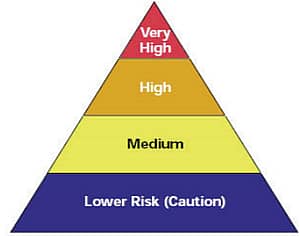OSHA recently issued a guidance document on Preparing Workplaces for COVID-19 that focuses on determining employees’ risk of occupational exposure to SARS-CoV-2 in order to identify the appropriate control measures that can be put in place to protect employees from exposure.
OSHA has divided job tasks into four risk exposure levels:
Very high exposure risk
Jobs with high potential for exposure to known or suspected sources of COVID-19 during specific medical, postmortem, or laboratory procedures. Workers in this category include healthcare workers (e.g., doctors, nurses, EMTs) performing aerosol generating procedures (e.g., intubation, cough induction procedures, invasive specimen collection); healthcare or laboratory personnel collecting or handling specimens from known or suspected COVID-19 patients; and morgue workers performing autopsies on people known or suspected of having COVID-19.
High exposure risk
Jobs with high potential for exposure to known or suspected sources of COVID-19. Workers in this category include healthcare and support staff (e.g., doctors, nurses, and other hospital staff who must enter patients’ rooms) exposed to known or suspected COVID-19 patients; medical transport workers moving known or suspected COVID-19 patients in enclosed vehicles; and mortuary workers involved in preparing (e.g., for burial or cremation) the bodies of people who are known or suspected to have COVID-19 at the time of their death.
Medium exposure risk
Jobs that require frequent and/or close contact (i.e., within 6 feet) with people who may be infected with SARS-CoV-2, but who are not known or suspected COVID-19 patients. In areas without ongoing community transmission, this may include workers with frequent contact with travelers who may return from international locations with widespread COVID-19 transmission. In areas with ongoing community transmission, workers in this category may have contact with the general public (e.g., schools, high-population-density work environments, some high-volume retail settings.)
Lower exposure risk (caution)
Jobs that do not require contact with people known to be, or suspected of being, infected with SARS-CoV-2, nor frequent close contact (i.e., within 6 feet) with the general public. Workers in this category have minimal contact with the public and other coworkers.
OSHA has noted that most workers will likely fall in the lower exposure risk or medium exposure risk levels. They have also provided additional guidance on risk group classification specific to clinical and research laboratory workers and employers.
As mentioned above, OSHA considers lab work involving the handling of specimens from known or suspected COVID-19 patients to be very high risk. Performing aerosol-generating procedures on samples that may or do contain SARS-CoV-2 is specifically mentioned as being very high risk. Medium risk lab work includes working in other areas of the laboratory physically separate from areas where SARS-CoV-2 samples are handled, in close proximity to other staff members. Lower risk lab work involves working in other areas of the laboratory physically separate from areas where SARS-Co-V-2 samples are handled, away from other staff members, or performing administrative duties in public areas or work sites away from other staff members. (Note that OSHA’s position is that the high risk category is not applicable for most laboratory tasks as the handling of any samples from known or suspected COVID-19 patients is considered to be very high risk.)
Although OSHA generally identifies lab procedures involving the handling of samples from COVID-19 patients as very high risk, as mentioned in a recent blog (Risk Assessments: The Key to Working Safely With COVID-19 Positive Samples), the level of risk will depend on many factors including the type of sample handled (e.g., respiratory samples are higher risk than blood samples). Per the WHO, CDC, PHAC, and ABSA, specimens from COVID-19 positive patients can generally be handled safely at BL2 containment, with enhanced practices based on the outcome of a biological risk assessment.
In its guidance document on Preparing Workplaces for COVID-19 , OSHA describes appropriate engineering controls, administrative controls, safe work practices, and appropriate PPE that are necessary as control measures to protect employees from exposure to SARS-CoV-2. This “hierarchy of controls” was discussed in a blog from earlier in the year (Hierarchy of Controls). The controls needed are based on employees’ exposure risk level. For most risk levels, a combination of control measures will be necessary to protect workers from exposure. However, for employees in the lower exposure risk group, additional engineering controls and PPE are not specifically recommended by OSHA.
For more information on assessing the exposure risk level for employees at your organization, or for assistance in identifying the appropriate workplace controls needed to protect your employees from exposure to SARS-CoV-2, please email [email protected].
